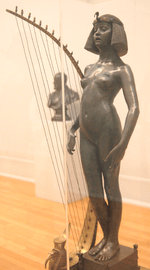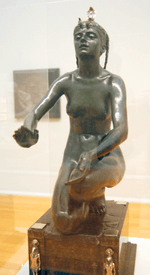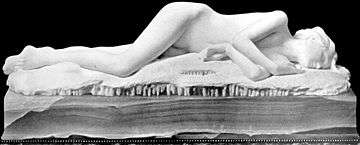Edward Onslow Ford
Edward Onslow Ford RA (27 July 1852, in London – 23 December 1901, in London) was an English sculptor.
E. Onslow Ford | |
|---|---|
_Onslow_Ford_by_John_McLure_Hamilton.jpg) 1893 portrait of Edward Onslow Ford by John McLure Hamilton. The work in progress appears to be Applause, completed in bronze the same year. | |
| Born | 27 July 1852 London |
| Died | 23 December 1901 (aged 49) |
| Nationality | British |
| Known for | Sculpture |
| Movement | New Sculpture |
| Spouse(s) | Anne Gwendoline von Kreuzer |
Life
Ford was born in Islington, north London on 27 July 1852, the son of London businessman Edward Ford and Martha Lydia Gardner. His family moved to Blackheath while he was still a child. After he had spent some time at Blackheath Proprietary School, his mother determined that he should follow the strong bent towards art which he had already shown. She took him to Antwerp, where she sent him to the Royal Academy of Fine Arts to study painting. From Antwerp they moved to Munich where Ford studied under Michael Wagmüller. Wagmüller advised Ford to focus on modelling, which he did. Before leaving Munich, Ford married Anne Gwendoline, the third daughter of Baron Frans von Kreusser, in 1873.
On returning to England around 1874, Ford settled at Blackheath. In 1875, he submitted a bust he had sculpted of his wife to the prestigious Royal Academy Summer Exhibition. This public display brought recognition to his work[1].
His important works include the statue of Rowland Hill at the Royal Exchange (1881); Irving as Hamlet (1883) depicting Henry Irving, found in the Guildhall Art Gallery; Gordon (1890), depicting General Gordon mounted on a camel[2]; the Shelley Memorial in University College, Oxford (1892); the equestrian statue of Lord Strathnairn at Knightsbridge (1895); and the memorial to Queen Victoria at Manchester (1901). The standing statue of William Ewart Gladstone (1894, for the City Liberal Club, London) is regarded as one of Ford's best portrait works. Ford's best known statue commissioned in India is the equestrian statue of Maharaja of Mysore, Chamarajendra Wadiyar X, installed in the famous botanical garden Lal Bagh in Bangalore. This statue was originally located at Curzon Park in Mysore but was relocated in 1894. The only other known statue commissioned in India is that of the philanthropist Maharaja Lakshmeshwar Singh Bahadur of Darbhanga found in Kolkata, West Bengal.[3]
In addition to these monumental works, Ford sculpted many busts which are noted for their tasteful conception, delicate modelling, and verisimilitude. The best, perhaps, are the heads of John Everett Millais, Huxley, Herbert Spencer, Sir WQ Orchardson, Matthew Ridley Corbet, the duke of Norfolk, Briton Rivière, Sir Lawrence Alma-Tadema, Sir Walter Armstrong, Sir Hubert von Herkomer, Arthur Hacker (1894), and M. Dagnan-Bouveret.[1]


Ford also modelled a series of bronze statuettes. In each of these he endeavoured to embody a playfulness which was occasionally less sculpturesque than literary.[1] The most successful of these, perhaps, are Folly (1886) (bought by the Chantrey Fund, and now in the Tate Gallery[4]), Linos, now in the Lady Lever Art Gallery, Port Sunlight, The Singer (1889), Applause, Peace (1890), Echo (1895), Glory to the Dead (1901) and Snowdrift (exhibited posthumously, 1902).
Ford was one of the first English sculptors to produce small replicas of his statues, which did much to extend his reputation.[1]
He died at his home in St John's Wood on 23 December 1901 and was buried at East Finchley. He was survived by his mother, his wife, four sons, and a daughter.[1] His obituary in The Sketch, dated 1 January 1902, states that he died of pneumonia exacerbated by a weak heart.
Assessment
Most of Ford's success came in portraiture. His busts are extremely refined and show his subjects at their best. Those in bronze of his fellow-artists Arthur Hacker (1894) and AJ Balfour are striking likenesses, as is the marble statue of Sir Frederick Bramwell for the Royal Institution.
Ford's influence on the younger generation of sculptors was considerable. His charming disposition rendered him extremely popular, and when he died, a monument was erected to his memory (Andrea Carlo Lucchesi, sculptor, J W Simpson, architect) in St John's Wood, near his home.[5] The monument comprises a stone pillar with a bronze seated figure in mourning at the front (based on Ford's statue The Muse of Poetry, a.k.a. Song and the mourning figure based on one in Ford's Shelley Memorial), and a wreathed bust of Ford at rear. It stands close to what is now the site of Abbey Road Studios and its famous zebra crossing (indeed, another zebra crossing allows access to the traffic island on which the monument stands).
References
| Wikimedia Commons has media related to Edward Onslow Ford. |
- Armstrong 1912.
- Replicas of Gordon may be found at the Royal Engineers Barracks at Chatham and at the Gordon's School in Woking.
- A Handbook for Travellers in India, Pakistan, Burma and Ceylon at Page 121. Author – Laurence Frederic Rushbrook Williams
- "Edward Onslow Ford, 'Folly' exhibited 1886". Tate Etc. Retrieved 9 September 2016.
- 51°31′54.6″N 000°10′37.3″W
- Attribution

- Chisholm, Hugh, ed. (1911). . Encyclopædia Britannica (11th ed.). Cambridge University Press.
External links
 |
| Ford's statue The Snowdrift |
- The Victorian Web
- Bob Speel's Site
- Art Renewal Center
- Peace – Flickr photo by Sheepdog Rex
- Tate Gallery Online
- Tate Britain: rare 19th and early 20th century sculpture – set by ketrin1407 on Flickr featuring works by Ford and others
- The Muse Transformed – Flickr composite photo by rayyaro, comparing The Muse of Poetry after and before restoration
- In Focus: The Singer exhibited 1889 and Applause 1893 by Edward Onslow Ford (index page to a set of articles about the two works)
- Profile on Royal Academy of Arts Collections